 |
|
|
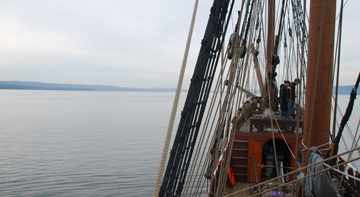
0700 hours
Current Position: Anchored off Mt. Hook at Haverstraw Bay.
Latitude: 41˚ 07.4'
Longitude: 073˚ 53.5'
Day Four of the 2008 Masters Voyage of Discovery.
We rise to find the skies cool, overcast, and becalmed. Sadly, although we have far to go to reach our destination, there will be no sailing today.
But before we begin our day, let's start with a letter from home!
|
 |
Thanks to all of the friends and familiy who've written in to our crew so far. One e-mail deserves special attention; Mrs. Chappell and Mr. Friedman, teachers at the Masters School, have asked our student crew members an intriguing question. Here's a sample reply:
| Mrs. Chappell and Mr. Friedman ask: |
| |
If you could share one insight that you have had about life in 1609 on that ship that never occurred to you until you experienced it, what would that insight be? |
 |
Bennett Responds: |
| |
During this trip I realized how dangerous the sailors’ job was. With climbing the rigging and weighing the anchor, even just being on the ship for the length of time they were and braving the storms while sailing was very dangerous.
The sailors did not have harnesses and because of that lack sailors, even experienced ones, faced a very big probability of falling. When you furl and unfurl sails you lie down on the yard and even with a harness doing that is very dangerous. When you weigh the anchor you face the chance of getting your hand mutilated if the capstan continues to rotate when you try to free rope from under the capstan on the orlop deck.
Staying on a boat in the middle of the ocean for the amount of time Hudson’s crew did you basically will always have to face a storm. With a storm comes a rocking boat and slippery decks and therefore the possibility of a man overboard.
Before I came aboard the Half Moon I didn’t realize the dangers of sailing. Now, I do. |
| |
|
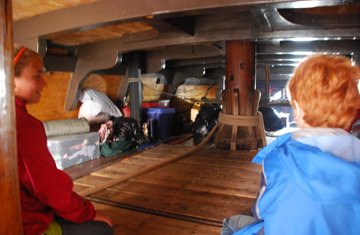
1000 hours
After a bagel breakfast, the crew has spent the last few hours conducting Deck Log research and tending to general ship duties while waiting for the tide to turn.
Now the ebb has come, so the crew is once again dispatched to weigh anchor. Today, the belowdecks team consists of Natalie and Ross the lower capstan...
|
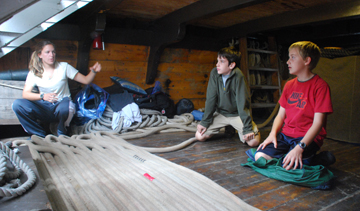
...while Ms. Smith oversees fakers Bennett and Luke.
|
Mouse over to walk the capstan.
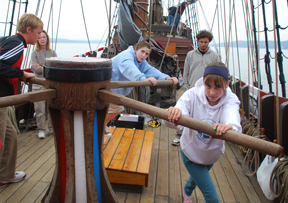 |
We go ahead and use the engine to ease the load on the anchor rode as our capstan team winds in the line.
Soon enough, the anchor's a-weigh and the Half Moon is on its way. By popular decision, our route for the day will take us past New York City to Grave's End Bay, where the Hudson River meets the Atlantic.
|
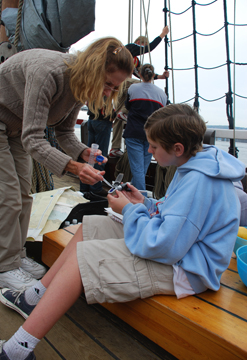
1100 hours
The students' main priority for the day is preparing to collect data for their presentations, but for most projects actual data collection will have to wait until we reach tonight's anchorage.
Until then, the Deck Log will certainly keep everyone busy! Here, Dr. Jacobs assists Peter with a salinity reading.
|
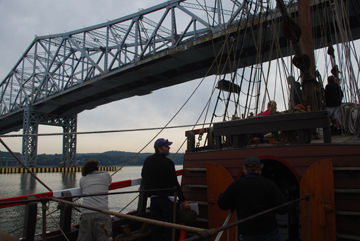
1115 hours
On our way out of Haverstraw Bay, we pass under the Tappan Zee Bridge, much to the excitement of our young crew.
|
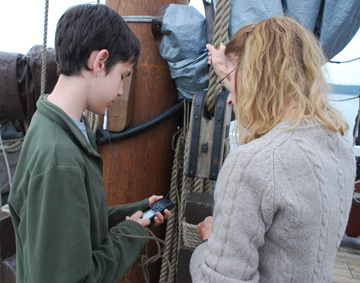
1145 hours
Bennett and his partner Jonathan are among the teams that can go ahead and start collecting data for their projects while the ship is still underway. As part of a salinity reading, he uses a GPS unit to check the ship's current position.
|

1200 hours
The Half Moon is now passing the town of Dobbs Ferry, home to the Masters School itself! Sadly, we weren't able to capture a good view of the school from our position on the river.
|
Photo by Heather Smith
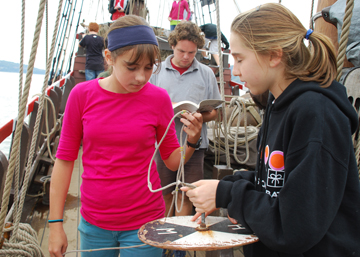 |
1215 hours
Evi and Lizzie fetch the Secchi disk in preparation for a test of the river's turbidity. In order to use the Secchi disk effectively, we bring the ship to a halt to prevent its forward motion from dragging the disk out of position.
Jena and Natalie intend to study turbidity in depth for their presentation project, but their data collection will have to wait until we reach Grave's End Bay.
|
Photo by Heather Smith
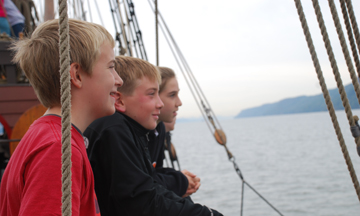 |
While the ship momentarily idles, Luke, Greg, and Lizzie pause to take in the western scenery -- the Palisades.
We'll take another look at those cliffs when we return upriver toward the conclusion of the voyage.
|
Photo by Heather Smith
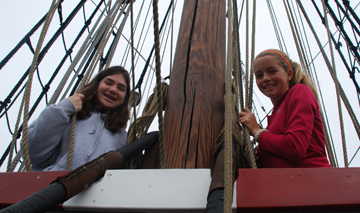 |
Meanwhile, Jena and Natalie stand lookout as part of their Duty Roster rotation.
After a few minutes, we've taken our readings and the Half Moon can continue on its way.
|
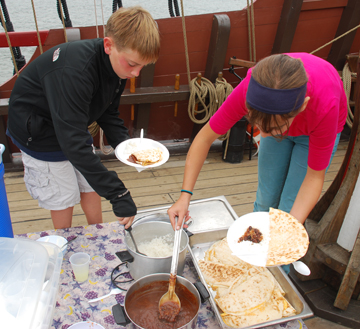
Moments later, lunch is served. We dig into Mr. McLaughlin's cheese quesadillas, rice, and beans.
|
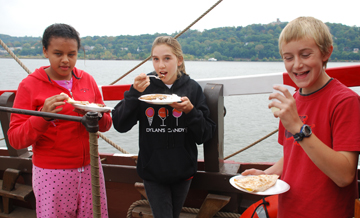
The hot meal hits the spot in the middle of a cool day.
|
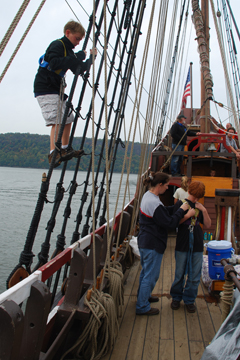
1245 hours
Greg and Ross need to wait for dusk to start collecting data points for their presentation -- tracking the course of the Moon.
In the meantime, they assist with the Deck Log by taking a shift to climb aloft and collect wind speed readings from the main top.
|
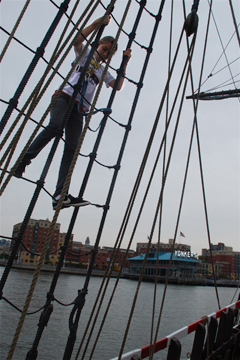
While Greg and Ross are on their way up, Lizzie works her way down.
As Lizzie reaches the bottom of the shrouds, we pass nearby the dock in downtown Yonkers -- our ultimate destination for this Voyage of Discovery, and where the Half Moon will be available for tours until the end of the month.
But let's not get ahead of ourselves; that's all still days away.
|
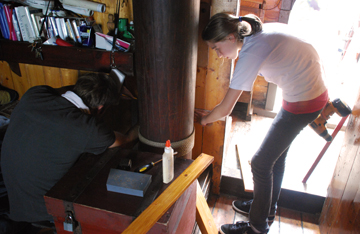
1330 hours
Students with free time remain eager to assist the senior crew with ship maintainance tasks. Mr. Schuijer recruits Lizzie to help affix some new planking in the bulkhead separating the helm hutch from the great cabin (traditionally, living quarters for the ship's officers).
|
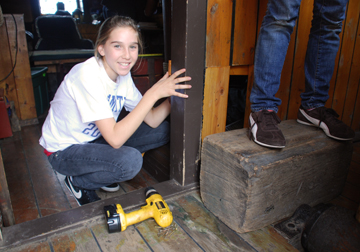
These planks were removed in order to perform maintenance on the mizzenmast prior to our Fall Voyage of Discovery last month; only just now have we had an opportunity to seal up the "cat door" once again.
|
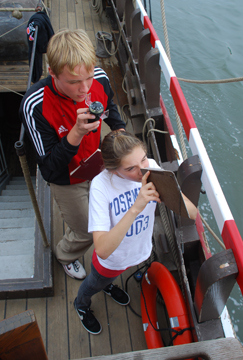
It's turning into a busy day for Lizzie! She and her partner Andrew are among the teams that can collect data for their presentations while underway. She momentarily excuses herself from the repair work to measure the Sun's altitude while Andrew marks its azimuth.
Today's overcast skies are providing Andrew and Lizzie with an additional hurdle in their research, but fortunately the clouds aren't so thick as to completely obliterate the Sun's position in the sky.
|
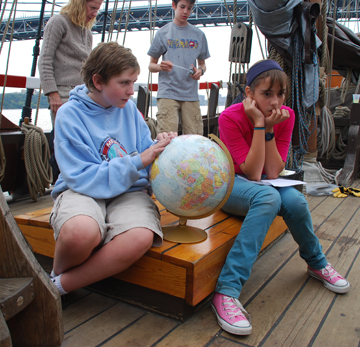
Along having the students maintain the Deck Log and collect data for their projects, the teachers have presented the student crew with a puzzling math problem to solve by the end of the day -- how does one create a triangle on a globe? It proves to be quite a conundrum!
|
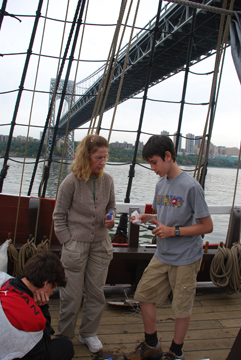
While Bennett and Jonathan test a water sample for their salinity experiments, the Half Moon passes under the George Washington Bridge. We have now reached Manhattan, but hours of travel remain between us and our goal for the day.
|
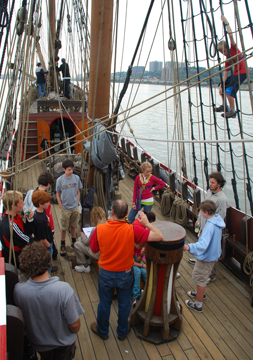
1345 hours
Captain Reynolds convenes a student crew meeting around the capstan. He explains that among the e-mail we've received came the question which opened today's log.
|
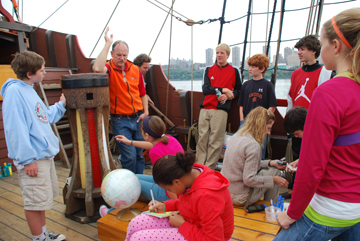
Captain Reynolds, Mr. Chase, and Mr. Hourigan ask the students to reply in their journals, requesting that they have answers ready by the end of the day so we can post a response for their classmates.
That request made, the captain releases the students back to their other duties.
|
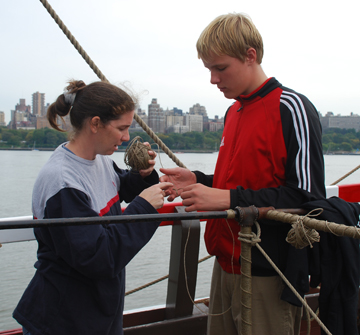
1400 hours
Andrew is particularly motivated to continue the fancywork railing project during his free time. After the meeting, Ms. Reilly helps him measure out a new length of twine to work with.
|
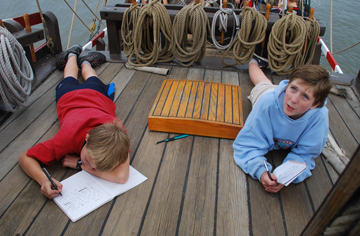
Meanwhile, Luke and Peter have relocated to the fore deck to write in their journals.
|
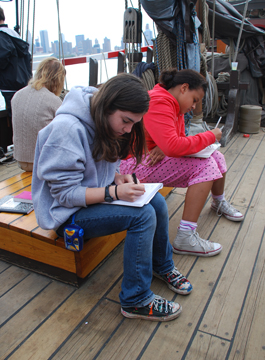
1415 hours
Jena and Christina have set up camp around the main hatch while answering Mrs. Chappell and Mr. Friedman's query.
|
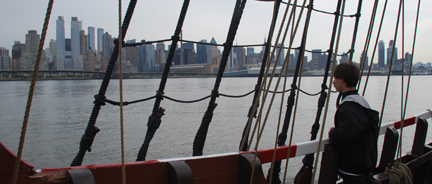
As the students write or ponder their answers, the skyline of midtown Manhattan slides past to the east.
|
Mouse over
to watch the ship's wake.
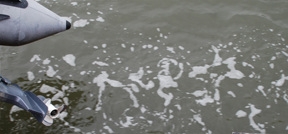 |
Our salinity readings have continued to rise steadily. The foam in our wake is a visual indicator that we have now entered a marine environment.
|
Mouse over
for a closer view.
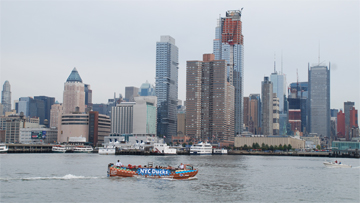 |
1430 hours
While the Half Moon motors south past New York City, a strangely familiar boat comes out to greet us.
The NYC Ducks are amphibious vessels that offer tours of the city. Each boat has been decorated in honor of the patterns on the Replica Ship Half Moon.
|

1445 hours
Work continues below decks as mid-afternoon rolls around. In the galley, Jena slices potatoes for tonight's dinner while Natalie helps clean up after making a batch of brownies.
|

1500 hours
We've reached the southern tip of Manhattan, original site of the village of New Amsterdam.
|
Mouse over to watch the Falls.
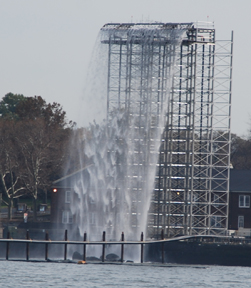 |
We take a special detour around Governor's Island (itself the location of the first Dutch outpost in the New World) to take in the Waterfalls, an ongoing art exhibit.
|
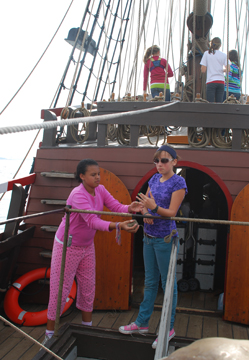
1515 hours
As we motor through New York Harbor, Christina and Evi return to their part of the fancywork project.
|
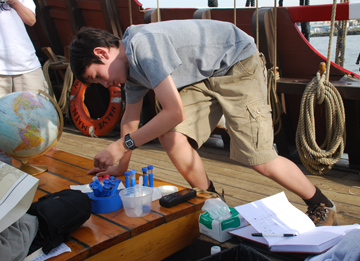
Meanwhile, Bennett remains focused on his salinity samples.
|
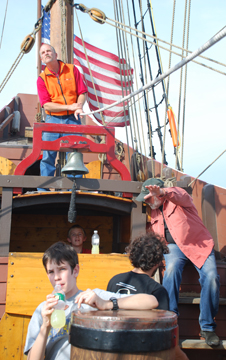
1530 hours
Although the water traffic is relatively light today -- we assume due to the fact that today is Columbus Day, a national holiday -- New York Harbor remains a bustling locale. Captain Reynolds and Mr. Hansen guide helmsman Luke through the harbor.
|
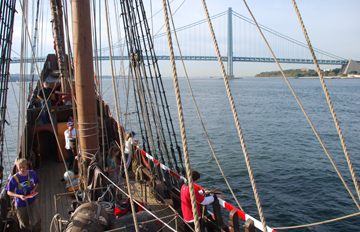
1630 hours
We have just passed the Verrazano-Narrows Bridge, which connects Brooklyn to Staten Island. By passing under the bridge, we've entered Grave's End Bay, and are now within sight of tonight's anchorage.
|
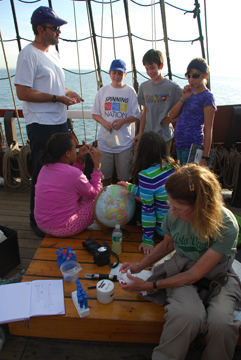
1645 hours
The triangle-globe conundrum continues to confound the students. To offer them some relief, Mr. Hourigan suggests a few paths to the solution.
|
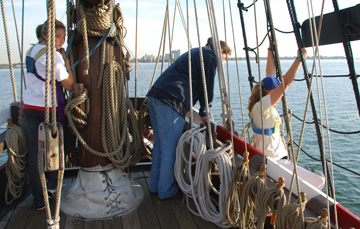
1700 hours
As we approach the Brooklyn waterfront, we dispatch the senior crew to anchor detail. While Lizzie stands lookout, the fore deck team moves into place.
|
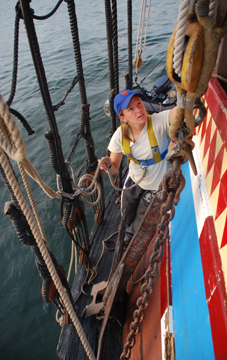 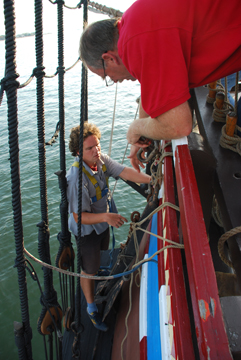
Grave's End Bay will be the location of this voyage's data collection layover; this means that we'll remain at anchor here for the next two nights, allowing the students an opportunity to place their full attention on their presentation projects.
Keeping the Half Moon at a fixed location will greatly assist several of the students' projects. When the ship is secured by a single anchor, it regularly turns around the anchor rode, pushed by the wind and current. In order to pin the ship in place, we will deploy two anchors rather than one, keeping the Half Moon suspended between them.
While Ms. Smith reports to the starboard fore channel to tend the primary anchor, Mr. Morel climbs out to the port fore channel to prepare the reserve anchor for use as well. This will be Ms. Smith's first opportunity to work on the channel while deploying the anchor.
|
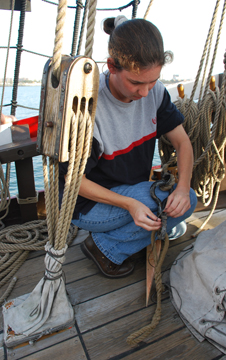
While Captain Reynolds, Mr. Schuijer, and Mr. Morel work below decks to prepare a rode for the reserve anchor, Ms. Reilly rigs a grommet to hold the reserve anchor's fid in place.
|
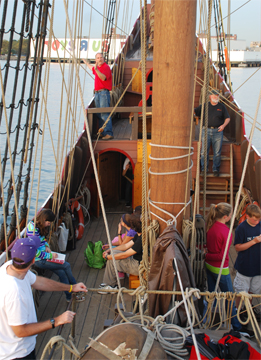
1800 hours
Both anchors are now ready to be deployed. Captain Reynolds calls for the crew's attention, explaining the procedure we'll be using as well as the accuracy it will add to the students' data points.
(Any product placement in this photo is entirely coincidental, as a note.)
|
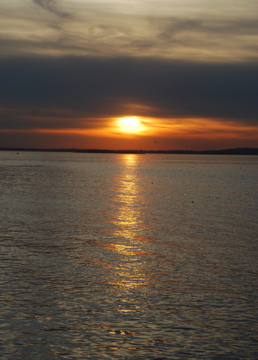
1815 hours
As the Sun sets over Staten Island, we run out the reserve anchor.
|
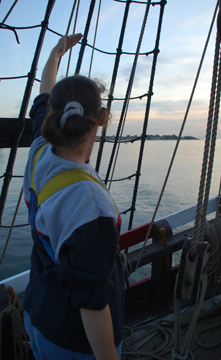
1815 hours
The reserve anchor rode is more typically used as a backup mooring line, and as such is made of a material that tends to float. Ms. Reilly indicates the curving lead of the secondary rode for the benefit of the Quarter deck.
|
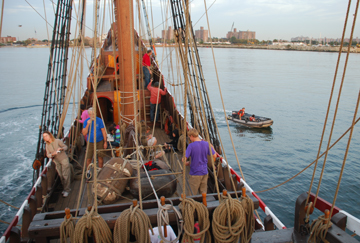
To tend to the floating rode, Mr. Schuijer recruits Bennett to join him in the Zodiac. They quickly zip out and weight the rode with iron shackles, sinking it to the bottom and thus improving the reserve anchor's grip.
|
Mouse over for the "after" picture.
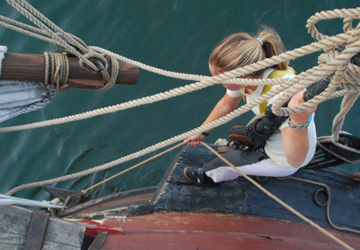 |
1830 hours
With the reserve line now secure and holding, we maneuver into position and can finally set the primary anchor as well. When the command comes to "Let fall!" Ms. Smith yanks on the carrot -- and it pops free on her very first try! A cheer goes up from her crewmates on the fore deck.
The primary anchor plunges to the bottom as intended.
|
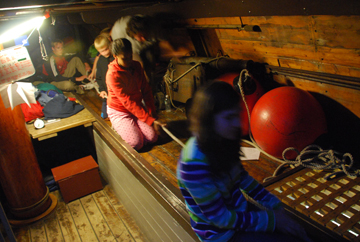
1845 hours
The ship is nearly secure; just one last task to perform. The students line up on the orlop deck to haul in (and thus snug up) the secondary anchor rode. There's no mechanical advantage here -- purely the students' combined strength in a tug of war against the weight of the rode and the strength of the current.
All goes according to plan, however, and in the end the Half Moon is affixed in place.
|
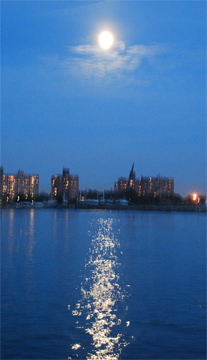
1900 hours
As a nearly-full moon rises over Brooklyn, our evening activities begin. Dinner is served as soon as the anchor detail is completed. Tonight's dinner consists of ham, scalloped potatoes, and applesauce.
Immediately after dinner, Greg and Ross start tracking the Moon for their presentation.
1900 hours
Captain Reynolds convenes the evening's anchor watch briefing, after which the students retreat to their bunks on the orlop deck to update their journals and relax before lights out.
The Half Moon will remain anchored here at Grave's End Bay through tomorrow night. A cloudy weather front is moving through the region, but we expect our calm, cool weather to continue.
Next: Layover at Grave's End!
|
On October 1st, 1609:
The first of October, faire weather, the wind variable between the West and the North. In the morning we weighed at seven of the clocke with the ebbe, and got downe below the Mountaynes, which was seven leagues. Then it fell calme and the floud was come, and wee anchored at twelve of the clocke. The people of the Mountaynes came aboord us, wondring at our ship and weapons. We bought some small skinnes of them for Trifles. This after-noone, one Canoe kept hanging under our sterne with one man in it, which we could not keep from thence, who got up by our rudder to the Cabin window, and stole out my Pillow, and two Shirts, and two Bandeleers. Our Masters Mate shot at him, and strooke him on the brest, and killed him. Whereupon all the rest fled away, some in their Canoes, and so leapt out of them into the water. We manned our Boat, and got our things againe. Then one of them that swamme got hold of our Boat, thinking to overthrow it. But our Cooke took a Sword, and cut off one of his hands, and he was drowned. By this time the ebbe was come, and we weighed and got downe two leagues, by that time it was darke. So we anchored in foure fathomes water, and rode well.
-- Robert Juet's Journal.
|
|
|
|
|
|



